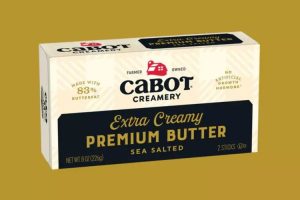
Butter, or lard in Argentina, Paraguay and Uruguay, is a more or less solid emulsion, product of the churning, kneading and washing of milk fats and water, which can carry in its process a biological maturation produced by specific lactic bacteria.
It is obtained by churning the milk cream, which causes the membranes of the fat to break down, allowing it to join into a mass: to obtain 1 kg of butter we need more than 20 liters of milk.
Butter is rich in vitamin A, contains vitamin D and vitamin E. It has more than 730 kcal per 100 g. and 63% of saturated fatty acids, 26% of monounsaturated fatty acids and 3.7% of polyunsaturated fatty acids. In addition, it contains cholesterol, some protein and water.
With toast at breakfast, with green Milo on the beach, “pipoca” at the movies, and melted with honey in the evening to soothe a sore throat in Brazil.
In Ayurvedic medicine and traditional cosmetics, ghee, as its butter is called, has medicinal properties and is used as a natural lubricant in massage and yoga practice in India, where more butter is produced and consumed than in any other nation in the world, devoting almost half of its milk production to its manufacture.
In terms of consumption, Germany is second only to India, followed by France, Russia and the United States, where butter is used in cookie dough, and to keep cookies from sticking. To get a tight ring off or to relieve a burn.
In Argentina we know it is in the dough of croissants, as an alternative to vegetable oils, and in creams and lotions for skin and hair care, in the mocha cream that fills my mom’s favorite birthday cake, in locro and mashed potatoes.
Butter is in the preparation of traditional Australian and New Zealand dishes such as roast beef, and fish and chips.
There are different varieties of butter in the world. Smen in Morocco, yak milk butters are very important in Tibet and in the Himalayan regions, Bhutan, Nepal and India, as already mentioned. In Africa and in Asia, where it is extra traditional to make it with sour milk instead of cream.
Butter has uses that we did not imagine in different industries such as textile and automotive for its lubricating, emulsifying, moisturizing and softening properties.
Butter is used in the preparation of some meat products: to improve the flavor and texture of some meat products, such as sausage and ham. And it is a common ingredient in the pharmaceutical industry as an excipient and to treat respiratory problems and joint pain.
The world butter market has a large number of players competing for international market share. Some of the major companies operating in the market are Fonterra Co-operative Group, Arla Foods, Dairy Farmers of America, Cropp co-oporative, Gujarat Cooperative Milk Marketing Federation (GCMMF), Ornua and among others.
“Butter-art”
The first butter sculptures appeared1536 and still at the beginning of the 21st century very popular at agricultural fairs, banquets and restaurants.
The oldest records of butter sculptures are in Europe where they were placed on banquet tables. The earliest pieces in the modern era as a form of public art date back to the 1870s in the United States, and were created by Caroline Shawk Brooks, a farm woman from Helena, Arkansas.[1] The first pieces in the modern era as a form of public art date back to the 1870s in the United States, and were created by Caroline Shawk Brooks, a farm woman from Helena, Arkansas.[1
Consuming dairy is good for you, and in this article we learn a few more things about this incredible food, a must in our refrigerators.
Before we say goodbye until next time, I want to know: Have you had your glass of milk today?























